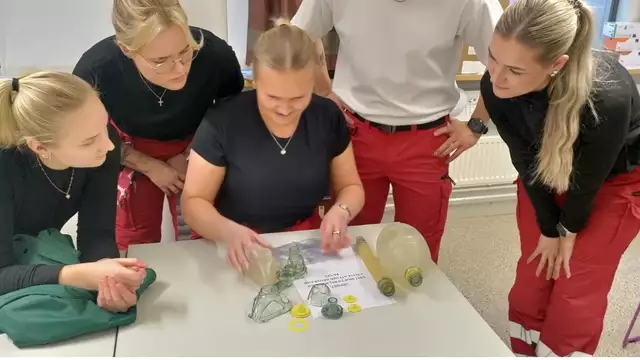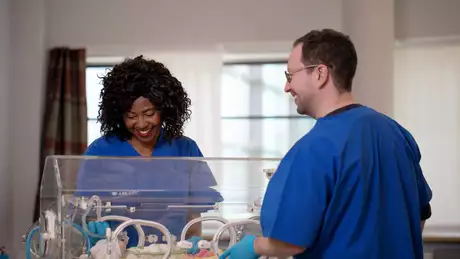
Could healthcare students peer facilitate clinical learning? – The PeerSIM Project
Published: 18.03.2024 / Publication / Blog
The earlier we learn to facilitate debriefing in simulation and skills training, the stronger our knowledge base will be later on as (healthcare) professionals. Imagine if debriefing and reflection skills could be initiated, in a systematic and structured fashion during undergraduate (nursing) studies? This is PeerSIM; building Self-efficacy, Inspiration and Mastery in peer-learning for our students.
Let us agree that simulation-based learning (SBL) is a well-established modality for reflective learning. (Abildgren et al., 2022; Brazil V, 2023; Duff et al., 2024; Guerrero, Hafiz, Eltohamy, Gomma, & Jarrah, 2021) While simulation is perhaps still most prominently used within its initial contexts of healthcare and aviation, due to its versatility, SBL or variants of it, have built contemporary bridges into new contexts, such as business administration and leadership (Kräkin M, 2023; Levant, Coulmont, & Sandu, 2016), even utilising novel and fun SBL table-top activities for learning systems thinking External link. (Fusco, Foltz-Ramos, Jacobsen, & Gambacorta, 2024)
The central premise behind SBL, regardless of its use context, is the combination of action and reflection, as formulated in Kolb’s circle of experiential learning External link. The idea with SBL is, that learners experience both concrete ‘doing’ in a safe and controlled environment (i.e. flying an airplane, treating a critically ill patient with an emergency team or even running a tough business negotiation), while then applying critical thinking and conceptualisation of one’s own, and/or others, performance and practice via a structured reflective debriefing. (Brazil V, 2023; Ericsson, 2021) Ideally, this would then be followed by the learner(s) applying their new-found knowledge into his or her professional practice. (Brazil V, 2023; Ericsson, 2021) Furthermore, let us agree that SBL, and more specifically debriefing, lean heavily towards the principles of guiding (rather than lecturing) learners in shaping an understanding of their own knowledge, more often in line with a constructivist approach to learning, where learning encourages students to use active techniques, like experiments and real-world problem solving, to create knowledge and reflect on their understanding, turning the student from a passive recipient to an active learner. (Christiansen, Andersen, & Dieckmann, 2023; Duff et al., 2024; Ericsson, 2021). In other words, debriefing aims to move the traditional ‘sage on the stage’ didactics toward an approach more akin to ‘guide on the side’; the facilitator is not necessarily the context expert in the room, although some knowledge is undoubtedly necessary, but acts more as enabler of the learning process. (Duff et al., 2024) We can agree to all this, but the follow-up question becomes somewhat trickier. Considering the aforementioned; who should be that moderator, who should facilitate simulation or the learning process? And how trained would you need to be?
PeerSIM: Building self-efficacy, inspiration and mastery in peer-learning students
Arcada Patient Center and Learning (APSLC) has a long-demonstrated history of simulation education, being a certified EuSim center since over fifteen year and decorated by The Finnish Society for Patient and Client Safety in 2021 for outstanding work in simulation education during the Covid-19 pandemic. APSLC also has wide networks of international and national contacts to simulation industry, other universities and SBL research networks. Adding to that, the newly finished fundraising project (Arcada 25) has enabled APSLC to develop and actualise plans for a new Skills Lab, a modernised digital system and also, hopefully, in the future, a dedicated simulation developer. These are naturally all of benefit. APSLC is further administered by a centralised executive committee, committed interprofessional members of the teaching faculty, all experienced in SBL and peer learning, who have also created and run annual faculty development programs for the simulation teaching faculty. In other words, the foundations for interprofessional experience, expertise and technology already exist at APSLC to start systematically training our healthcare students into peer facilitators for skills workshops and even simulation co-facilitators.
We described simulation and debriefing as a conduit for reflective learning and we recognised that facilitation is more about moderating the learning experience than being the most knowledgeable expert lecturer. This is a skill we could teach also to our students, by giving them the right tools and enough guidance, as shown in work by Christiansen et al. and Stenberg and Carlson. (Christiansen et al., 2023; Wang & Ji, 2021) And by doing so, we further have the potential to strengthen their self-efficacy, inspire them to develop and attain mastery levels (SIM), both in their own clinical context (be they paramedics, nurses, midwives or public health nurses) but also as future educators, all the while simultaneously facilitating learning in their peer students. The quotations embedded in this text are from a final-year student acting as simulation co-facilitator together with a senior lecturer, during a day of simulation with younger Emergency Care students. It showcases the many dimensions of experiences we could explore and tap into. Naturally, for it to be feasible and sustainable, this would require systematic and rigorous planning, testing and execution, along with personnel resources and networking, while gathering continuous data on progressions, competences, development and any support needed by the learners. (Stenberg & Carlson, 2015)

”Facilitating simulations for younger students feels good, and I hope I can share my knowledge and that it would also benefit them in their later simulations and professional life.”
Facilitation of debriefing is a social practice requiring a combination of skills, knowledge, experience and yes, it is even an art. (Ericsson, 2021) Like a trained ballet dancer following a semi-choreographed sequence through the ‘stage’ of observation and reflection, while leaving room for improvisation, the facilitator figuratively works through the group discussion, holding on to those moments where learning value is considered high, while gracefully breezing past those that maybe add less. To achieve such a level of aptitude undoubtedly requires both training and experience. Standardised facilitation courses, for novice and experienced debriefers alike, are available; one of them being the EuSim concept External link run at Arcada. This makes absolute sense; we do need tools, training and even theoretical knowledge to effectively facilitate and advance learning through debriefing processes (Duff et al., 2024; Ericsson, 2021). Without the right understanding, we might easily find ourselves in a veritable minefield of lost learning opportunities, wasted time or at worst, unwittingly create long-lasting and psychologically unsafe experiences for our learners. (Purdy et al., 2022) It has been shown that facilitation techniques and frameworks (of which there are various), at minimum, offer clarity and structure, which frees up both the facilitators’ and learners’ cognitive load, thus enabling their concentration on actual facilitation and sensemaking. (Kumar & Somerville, 2024) Like having a good roadmap on a hike, if you know where you are heading, the eventual surprises become easier to manage. Further, like all form of learning, these tools will need “tuning and repairing” in order to stay in shape, i.e. we need to refresh, train and reshape our debriefing and reflection skills continuously. So, let us now hypothesize that the earlier we learn to debrief, the stronger our knowledge base will be later on as (healthcare) professionals. Further imagine if debriefing and reflection skills could be initiated, in a systematic and structured fashion, as peer learning activities during undergraduate (nursing) studies?
You mean nursing students training other nursing students?
Admittedly, this idea is not that novel in itself. Successful peer learning projects have been utilised in many forms and simulation activities before, such as medical students running courses as simulation faculty, at Copenhagen Academy for Medical Education and Simulation (CAMES) in Denmark (Viggers, Østergaard, & Dieckmann, 2020) or at Akuuttipaja External link, the medical student-run simulation/skills center at University of Helsinki Faculty of Medicine since 2022. And there is also evidence to back this up. In healthcare education, for instance, there is some evidence that peer learning, i.e. the learning from students on similar, or near-similar, level of competence, might show several benefits among learners, including improved critical thinking, communication abilities, teamwork skills and self-direction skills (Christiansen et al., 2023; Sriwigati & Musharyanti, 2022). Peer learning can also help students in developing a deeper understanding of the subject matter and improve their confidence in their own abilities as teachers and professionals. (Sriwigati & Musharyanti, 2022) In simulation-based learning environments, peer learning can, at best, be particularly effective in helping students develop their clinical reasoning and decision-making skills. (Wang & Ji, 2021) Contemporary research further suggests that peer learning could be an effective approach to healthcare education. A recent study found that peer learning was associated with improved academic performance and increased student engagement in a simulation-based learning environment. (Wang & Ji, 2021) This could thus potentially translate into better study performance. So, while more research is indeed needed to fully understand the benefits and challenges of peer learning in healthcare education, there seems to be potential for even long-term benefits, considering students’ shaping of their own professionalism.
"Experienced students who have participated in simulations, can give valuable insights for the debriefing, building on their own previous performances and discussions. It can thus be easier to find ‘common ground’ with the younger student groups."
In addition to the abovementioned, there are also pragmatic advantages involved; in a university environment, where faculty time and resources are generally sparse, having motivated and invested peer learners/co-faculty involved as autonomous actors has the potential to add focused and repeated learning moments, while simultaneously freeing up valuable faculty for such teaching and learning actions, which would then perhaps require more traditional didactic methods or lean on their expert experience.

But is that even safe? How can we manage them?
Of course, peer learning in healthcare education does presents several challenges, which would need to be addressed. One of the main challenges is ensuring that the students involved are adequately prepared to participate in peer learning activities. This would thus necessitate a careful selection process of potentially interested and invested candidates and would then further require trained faculty provide these students with the necessary training and support to develop the skills needed for effective peer learning. (Stenberg & Carlson, 2015) Another challenge is ensuring that students are motivated to participate in peer learning activities. This could be achieved by creating a supportive learning environment that encourages these students to take an active role in their learning. (Stenberg & Carlson, 2015) Something akin to building a “deliberately developmental organization” (Miller, Nagler, Wolff, Schumacher, & Pusic, 2023), where a coaching culture within SBL and peer learning could then become a central theme. Peer learning can further be challenging if students have differing levels of competences. This could, however, be addressed by creating groups of students with similar levels of knowledge and skills (Jassim, Carlson, & Bengtsson, 2022) and building a support system, where the students across such groups could support and build on each other.
”I had previous experience debriefing a simulation for teachers. I felt I was rather good at it and liked doing it. My main motivation to join as co-facilitator now was receiving good feedback from this previous experience and wanting to support the younger generation of paramedics.”
Most importantly, educators involved would need to adapt and create a psychologically safe learning environment by being accessible and approachable preceptors. (Ericsson, 2021; Hardie, O’Donovan, Jarvis, & Redmond, 2022; Stenberg & Carlson, 2015) Such preceptors could provide peer learning students with necessary guidelines and support to facilitate a psychologically safe learning environment, such as by creating a supportive learning environment that encourages students to take an active role in their own learning. (Hardie et al., 2022) Additionally, preceptors could provide students with opportunities to practice their own communication and teamwork skills through peer learning activities. (Stenberg & Carlson, 2015)
Could we then agree that there is potential to make it happen; PeerSIM, a future of peer-assisted learning in simulation and clinical skills training with our students, and for our students, together at Arcada Patient Safety and Learning Center?
Disclaimer: The blog text was fully conceived, outlined and written by the author. Parts of the text, related to the evidence-based background of peer-learning, were originally based on text outputs and references generated by Microsoft Copilot (Bing AI; 2024) then checked, rephrased and reformatted by the author.
References
Abildgren, L. A.-O., Lebahn-Hadidi, M., Mogensen, C. B., Toft, P., Nielsen, A. B., Frandsen, T. F., . . . Hounsgaard, L. (2022). The effectiveness of improving healthcare teams' human factor skills using simulation-based training: a systematic review. (2059-0628 (Electronic)).
Brazil V, P. E., Bajaj K (Ed.) (2023). Simulation As Improvement Technique. Cambridge, UK: Cambridge University Press.
Christiansen, C. R., Andersen, J. V., & Dieckmann, P. (2023). Comparing reflection levels between facilitator-led and student-led debriefing in simulation training for paramedic students. Advances in Simulation, 8(1), 30. doi:10.1186/s41077-023-00273-0
Duff, J. P., Morse, K. J., Seelandt, J., Gross, I. T., Lydston, M., Sargeant, J., . . . Kolbe, M. (2024). Debriefing Methods for Simulation in Healthcare: A Systematic Review. Simulation in Healthcare, 19(1S). Retrieved from https://journals.lww.com/simulationinhealthcare/fulltext/2024/01001/debriefing_methods_for_simulation_in_healthcare__a.12.aspx External link
Ericsson, C. L., Niko; Stenbäck, Pernilla; Paakkonen, Heikki. (2021). Simulation-Based Education: Beyond Experience or Evaluation to Genuine Reflective Learning. In S. T. Kiukas C, Tigerstedt C, Haldin D (Ed.), Utforskning av pedagogisk praktik - en drivkraft för framtidens Arcada.
Fusco, N. M., Foltz-Ramos, K., Jacobsen, L. J., & Gambacorta, J. (2024). Educational game improves systems thinking, socialization, and teamwork among students of 13 health professions programs. Journal of Interprofessional Care, 38(1), 176-181. doi:10.1080/13561820.2023.2243307
Guerrero, J. G., Hafiz, A. H., Eltohamy, N. A. E., Gomma, N., & Jarrah, I. A. (2021). Repeated Exposure to High-fidelity Simulation and Nursing Interns’ Clinical Performance: Impact on Practice Readiness. Clinical Simulation in Nursing, 60, 18-24. https://doi.org/10.1016/j.ecns.2021.06.011 External link
Hardie, P., O’Donovan, R., Jarvis, S., & Redmond, C. (2022). Key tips to providing a psychologically safe learning environment in the clinical setting. BMC Medical Education, 22(1), 816. doi:10.1186/s12909-022-03892-9
Jassim, T., Carlson, E., & Bengtsson, M. (2022). Preceptors’ and nursing students’ experiences of using peer learning in primary healthcare settings: a qualitative study. BMC Nursing, 21(1), 66. doi:10.1186/s12912-022-00844-y
Kräkin M, M.-N., S. (2023). Simulaatio-oppimisen avulla harjoitellaan tosielämän työtilanteita turvallisessa ympäristössä. Retrieved from https://lab.fi/fi/tarina/simulaatio-oppimisen-avulla-harjoitellaan-tosielaman-tyotilanteita-turvallisessa External link
Kumar, P., & Somerville, S. (2024). Exploring in-person self-led debriefings for groups of learners in simulation-based education: an integrative review. Advances in Simulation, 9(1), 5. doi:10.1186/s41077-023-00274-z
Levant, Y., Coulmont, M., & Sandu, R. (2016). Business simulation as an active learning activity for developing soft skills. Accounting Education, 25(4), 368-395. doi:10.1080/09639284.2016.1191272
Miller, K. A.-O., Nagler, J. A.-O., Wolff, M. A.-O., Schumacher, D. A.-O., & Pusic, M. A.-O. (2023). It Takes a Village: Optimal Graduate Medical Education Requires a Deliberately Developmental Organization. Perspect Med Educ(2212-277X (Electronic)).
Purdy, E., Borchert, L., El-Bitar, A., Isaacson, W., Bills, L., & Brazil, V. (2022). Taking simulation out of its “safe container”—exploring the bidirectional impacts of psychological safety and simulation in an emergency department. Advances in Simulation, 7(1), 5. doi:10.1186/s41077-022-00201-8
Sriwigati, D., & Musharyanti, L. (2022). Benefits and challenges of peer learning methods in health professional students: A literature review. Bali Medical Journal, 11, 1626-1631. doi:10.15562/bmj.v11i3.3755
Stenberg, M., & Carlson, E. (2015). Swedish student nurses’ perception of peer learning as an educational model during clinical practice in a hospital setting—an evaluation study. BMC Nursing, 14(1), 48. doi:10.1186/s12912-015-0098-2
Viggers, S. A.-O., Østergaard, D., & Dieckmann, P. (2020). How to include medical students in your healthcare simulation centre workforce. Advances in Simulation(2059-0628 (Electronic)).
Wang, Y., & Ji, Y. (2021). How do they learn: types and characteristics of medical and healthcare student engagement in a simulation-based learning environment. BMC Medical Education, 21(1), 420. doi:10.1186/s12909-021-02858-7

